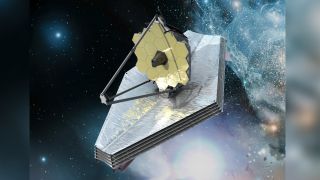James Webb Space Telescope
About
- The James Webb Space Telescope is the world’s premier space science observatory.
- Webb is an international program led by NASA with its partners, ESA (European Space Agency) and CSA (Canadian Space Agency).
- Webb will solve mysteries in our solar system, look beyond distant worlds around other stars, and probe the mysterious structures and origins of our universe and our place in it.
- A key feature of Webb’s design is that it has a cold side and a hot side.
- The cold side is the one that does the observing, while the hot side carries the spacecraft’s solar panels and an antenna for two-way communication with Earth. But this arrangement only works if the sun and Earth are always facing in the same direction from the spacecraft’s point of view.
- One special distance at which an object can orbit the Sun and always see the Sun and Earth in the same direction is the so-called L2 point. It is where the Webb telescope operates.
- L2 is one of five locations in space called Lagrange points, after Joseph-Louis Lagrange who studied them in the 18th century.
- At these locations the gravity of two massive bodies (in this case the Sun and Earth) conspire to keep a third, smaller body (such as an asteroid or spacecraft) in a fixed position relative to the first two.
- The Lagrange points aren’t stationary, but they revolve around the Sun at exactly the same rate as the Earth, so the distance from us always stays the same.
- In the case of L2, it’s around 1 million miles (1.5 million kilometers) away: around four times as far away as the moon.

Objectives
The science goals for the Webb can be grouped into four themes.
- The early universe: Webb is used to look back around 13.5 billion years to see the first stars and galaxies forming out of the darkness of the early universe.
- Galaxies over time: It can be used to compare the faintest, earliest galaxies to today’s grand spirals and understand how galaxies assemble over billions of years.
- Lifecycle of stars: It can be used to see where stars and planetary systems are being born.
- Other worlds: It is used to observe the atmospheres of extrasolar planets (beyond our solar system), and perhaps find the building blocks of life elsewhere in the universe. The telescope will also study objects within our own Solar System.
What’s in the news?
- James Webb Space Telescope spots earliest-known galaxy- JADES-GS-z14-0.
Additional Information
JADES-GS-z14-0
- JADES-GS-z14-0 measures about 1,700-light years across.
- A light year is the distance light travels in a year, which is 9.5 trillion km.
- The galaxy has a mass equivalent to 500 million stars the size of our Sun and is rapidly forming new stars — about 20 every year.
- Until now, the earliest-known galaxy dated to about 320 million years after the Big Bang, as announced by the JADES team last year.
- The fact that it’s so bright is also fascinating, given that galaxies tend to grow larger as the universe evolves, implying that it would potentially get significantly brighter in the next many hundred million years.
Sources
Subscribe
Login
0 Comments
